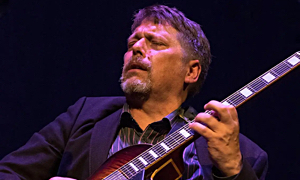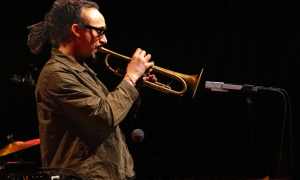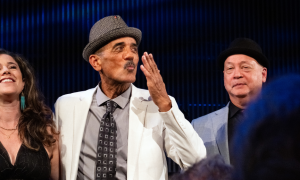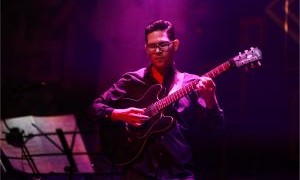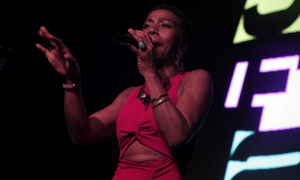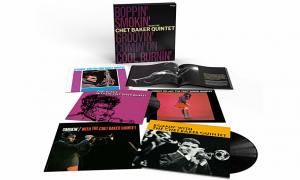Home » Jazz Articles » Live Review » Festival International de Jazz de Montreal 2005, Day 3
Festival International de Jazz de Montreal 2005, Day 3
As reported previously, the Montreal Jazz Festival likes to make its programming thematic. This usually applies by venue: the big-draw acts play the Theatre Maisonneuve; the Spectrum is for special working groups and festival-only collaborations; Gesù hosts small, intimate late night concerts; the Contemporary Art Museum is the site for obscure "avant garde performers. But it is possible to create your own themes, either through planning or serendipity, as you go from show to show. Day 3 was a day of percussion.
Despite the initial trepidation faced by this year's Invitation Series, it has been the grand success of the Festival because Hussain is such a charismatic performer and has made such smart choices with whom to perform. After having presented Indian classical music on Day 1 and contemporary Indian music on Day 2, he invited some "Jazz Friends to show how the preceding two forms can be used in a jazz-based improvisatory concept. His first invitation show (with Sultan Khan) was wonderful. The next day's Charles Lloyd Quartet concert was equally transcendent. The mix of Hussain with Charles Lloyd and drummer Eric Harland in a trio surpassed them both. Your correspondent saw this trio in Berlin last fall. Referring back to notes taken then, one thing becomes apparent. In Germany, it was billed as Charles Lloyd's show and he dominated it. Here, the percussive dialogues between Hussain and Harland were in the forefront, Lloyd more often staying within the boundaries erected by his two bandmates. Both ways worked out quite well; a slight advantage has to be given to the Canadian performance because it was more chance to hear the wonderful Eric Harland. He displays a deep understanding of rhythm (not a given with a trap drummer) and engaged Hussain in several compelling exchanges throughout the evening. ALIGN=CENTER> 
This is not to discount the bond that Hussain and Lloyd have developed. Both are intensely spiritual beings — Hussain from his Indian heritage and Lloyd from his Native American background and west coast lifestyle. The loose format of the pieces allowed Lloyd to be as expressive as he chose, laying blues licks over quick tabla/drum figures for example or playing with shenai-like abandon on top of scratchy hand drumming. Another delicious element to the music was when Harland switched to piano, playing ostinatos on the prepared keyboard in a nod to drones in traditional Indian music.
Hussain's melodicism and absolute control of the intricacies and subtleties of the tabla were discussed in detail in Day 1's report. Lloyd fits well with both that tradition and Harland's more "typical jazz kit approach. One might theorize that Lloyd's playing today is more in line with his playing the '60s than his many non-jazz records of the '70s. His tone is pure and rich, beautiful and clear. His alto flute sounds at times mysterious and at others oddly whimsical. There is whimsy to this trio; a sense that the three really enjoy playing with each other and are continually surprised by what at first may seem like a limited format can produce.
The phrase "World Music is overused and haphazardly assigned. However, the trio of Hussain, Lloyd and Harland play world music for the world. Not a random hodgepodge of styles mashed together indiscriminately but rather three individuals coming together to communicate as one unit. A triumph!
 The next show continued the percussive, globe-crossing theme. Randy Weston is a pianist very much concerned with rhythms and beats. He introduced each song with an explanation of its cultural context, be it Latin rhythms or ancient Egyptian foundations. It has been said that Jaki Byard was a walking musical encyclopedia. Well, Weston brings millennia to his music, absorbing thousands of years of world tradition and broadcasting through a jazz megaphone. With him was bassist Alex Blake, who wowed the crowd with his seated, heavily percussive upright bass attack. Though Weston and guest Candido, conguero supremo, were the top billing, Blake stole the show with his unique approach. Also featured was secondary percussionist Neal Clarke who added the more modern Latin element. But the real wonder came from Candido, in his mid 80s. The man who invented to modern conga format (three drums in a row) still plays with verve and excitement and the energy of someone half his age. He feels the rhythms he plays and they keep him young. Also of note was Weston's onstage banter featuring such wonderfully spiritual lines as "The original orchestra was Mother Nature and "Africa is not a continent, it is a spirit. Weston himself is close to 80 but you wouldn't guess it from his refreshingly awed appreciation of life and music.
The next show continued the percussive, globe-crossing theme. Randy Weston is a pianist very much concerned with rhythms and beats. He introduced each song with an explanation of its cultural context, be it Latin rhythms or ancient Egyptian foundations. It has been said that Jaki Byard was a walking musical encyclopedia. Well, Weston brings millennia to his music, absorbing thousands of years of world tradition and broadcasting through a jazz megaphone. With him was bassist Alex Blake, who wowed the crowd with his seated, heavily percussive upright bass attack. Though Weston and guest Candido, conguero supremo, were the top billing, Blake stole the show with his unique approach. Also featured was secondary percussionist Neal Clarke who added the more modern Latin element. But the real wonder came from Candido, in his mid 80s. The man who invented to modern conga format (three drums in a row) still plays with verve and excitement and the energy of someone half his age. He feels the rhythms he plays and they keep him young. Also of note was Weston's onstage banter featuring such wonderfully spiritual lines as "The original orchestra was Mother Nature and "Africa is not a continent, it is a spirit. Weston himself is close to 80 but you wouldn't guess it from his refreshingly awed appreciation of life and music.
The final performance was highly anticipated but sadly did not deliver. Pianist Geri Allen is always a beautiful player. Her contributions on Day 2 to Charles Lloyd's music reinforced that. She doesn't play or record as a leader all that often so the chance to hear her in trio as the main melodic voice was intriguing. Unfortunately, the rhythm section of Kenny Davis (bass) and Mark Johnson (drums) was too brash and bombastic to allow Allen's delicacy and intelligence to come through. During the set, Allen dedicated a song, "Angels, to Mal Waldron. Allen in many ways recalls that great pianist and some of his albums recorded in Europe during the '70s. However, those albums featured less-than-stellar rhythm sections but still were successful because Waldron would lead strongly. ALIGN=CENTER> 
At the performance in the sacral Gesù, Allen was swept up by her unsympathetic trio and played to their deficiencies. Davis played too fast and Johnson too loud (after having seen Hussain just hours before, Johnson's hand drumming was unremarkable). As a result, the same could be said for Allen, a tragedy for someone so talented. When playing with Paul Motian and Charlie Haden, or Dave Holland and Jack DeJohnette, Allen rises to her potential. Even the night before with Larry Grenadier and Eric Harland, she was crisp, expressive and multi-faceted. This correspondent's recommendation would either for her to have used the Lloyd rhythm section again or continue the solo piano theme started the night before with Fred Hersch and Bobo Stenson. Either one would have been an improvement.
Continue: Day 4
Tags
PREVIOUS / NEXT
Support All About Jazz
 All About Jazz has been a pillar of jazz since 1995, championing it as an art form and, more importantly, supporting the musicians who make it. Our enduring commitment has made "AAJ" one of the most culturally important websites of its kind, read by hundreds of thousands of fans, musicians and industry figures every month.
All About Jazz has been a pillar of jazz since 1995, championing it as an art form and, more importantly, supporting the musicians who make it. Our enduring commitment has made "AAJ" one of the most culturally important websites of its kind, read by hundreds of thousands of fans, musicians and industry figures every month.
















